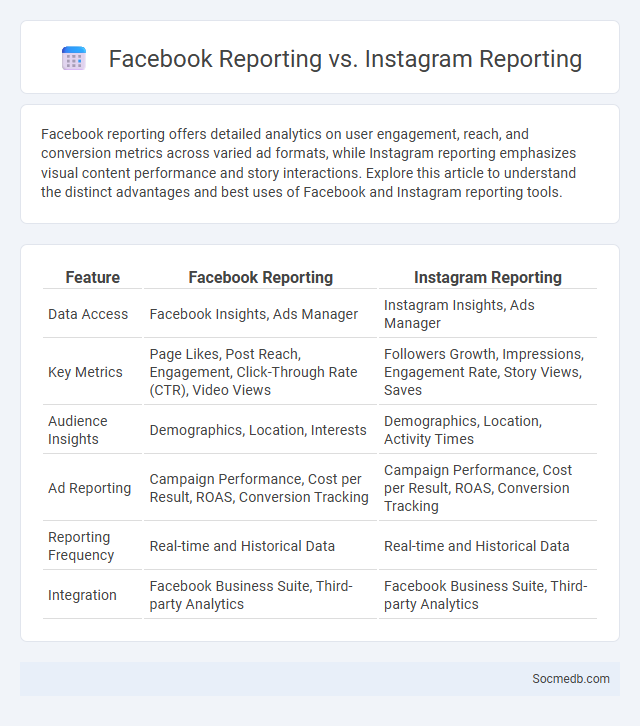
Photo illustration: Facebook Reporting vs Instagram Reporting
Facebook reporting offers detailed analytics on user engagement, reach, and conversion metrics across varied ad formats, while Instagram reporting emphasizes visual content performance and story interactions. Explore this article to understand the distinct advantages and best uses of Facebook and Instagram reporting tools.
Table of Comparison
| Feature | Facebook Reporting | Instagram Reporting |
|---|---|---|
| Data Access | Facebook Insights, Ads Manager | Instagram Insights, Ads Manager |
| Key Metrics | Page Likes, Post Reach, Engagement, Click-Through Rate (CTR), Video Views | Followers Growth, Impressions, Engagement Rate, Story Views, Saves |
| Audience Insights | Demographics, Location, Interests | Demographics, Location, Activity Times |
| Ad Reporting | Campaign Performance, Cost per Result, ROAS, Conversion Tracking | Campaign Performance, Cost per Result, ROAS, Conversion Tracking |
| Reporting Frequency | Real-time and Historical Data | Real-time and Historical Data |
| Integration | Facebook Business Suite, Third-party Analytics | Facebook Business Suite, Third-party Analytics |
Introduction to Social Media Reporting
Social media reporting involves analyzing and interpreting data from various social platforms to measure the effectiveness of your marketing strategies. Key metrics such as engagement rate, reach, impressions, and conversion help you understand audience behavior and campaign performance. Leveraging these insights enables you to optimize content, improve targeting, and achieve better ROI from your social media efforts.
Overview of Facebook Reporting
Facebook reporting provides detailed insights into user engagement, ad performance, and page analytics through tools like Facebook Insights and Ads Manager. These reports include metrics such as reach, impressions, clicks, and conversion rates, enabling businesses to optimize their social media strategies. Data segmentation by demographics, device types, and geographic locations allows for targeted analysis and improved campaign effectiveness.
Overview of Instagram Reporting
Instagram reporting offers detailed insights into your account's performance, including metrics such as follower growth, engagement rates, reach, and impressions. You can analyze post performance, story interactions, and audience demographics to tailor your content strategy. Utilizing these reports helps you optimize your Instagram presence and boost your social media effectiveness.
Core Differences: Facebook vs Instagram Reporting
Facebook reporting offers extensive demographic insights and detailed engagement metrics across posts, pages, and ads, allowing for comprehensive audience analysis. Instagram reporting emphasizes visual content performance, tracking metrics such as impressions, reach, follower growth, story interactions, and hashtag effectiveness specific to photo and video campaigns. Both platforms provide real-time analytics but differ in focus, with Facebook catering to broader marketing campaigns and Instagram specializing in influencer and brand engagement through visual storytelling.
Key Metrics Tracked on Facebook
Facebook key metrics tracked include engagement rate, which measures likes, comments, and shares relative to total followers, and reach, indicating the number of unique users who have seen a post. Page views and follower growth rate provide insights into audience expansion and content visibility. Tracking click-through rate (CTR) on links shared helps evaluate the effectiveness of call-to-action posts and advertising campaigns.
Key Metrics Tracked on Instagram
Instagram key metrics tracked include engagement rate, measuring likes, comments, and shares relative to followers to assess content interaction levels. Follower growth rate indicates the speed at which an account gains new followers, reflecting audience expansion. Impressions and reach track how many times posts are viewed and the unique number of users exposed to content, helping evaluate visibility and campaign effectiveness.
Reporting Tools and Dashboards Comparison
Leading social media platforms offer robust reporting tools and dashboards that provide in-depth analytics on user engagement, reach, and content performance. Tools like Facebook Insights, Twitter Analytics, and Instagram Insights feature customizable dashboards with real-time data visualization, enabling precise tracking of campaign metrics and audience demographics. Comparing these, platforms differ in data granularity and export options, with third-party tools like Hootsuite and Sprout Social providing integrated multi-platform reporting and advanced sentiment analysis.
Integration: Unified Reporting Across Platforms
Unified reporting across social media platforms enables marketers to consolidate data from channels such as Facebook, Instagram, Twitter, and LinkedIn into a single dashboard. This integration enhances analytics by providing comprehensive insights into engagement, reach, and conversion metrics, facilitating more informed decision-making. Streamlined data aggregation supports efficient campaign optimization and cross-platform performance comparisons.
Challenges in Social Media Reporting
Social media reporting faces challenges such as data accuracy, the rapid spread of misinformation, and algorithmic bias that can skew content prioritization. The sheer volume of user-generated content complicates real-time monitoring and effective sentiment analysis. Privacy concerns and compliance with evolving regulations like GDPR also restrict data accessibility for comprehensive reporting.
Best Practices for Effective Social Media Reporting
Effective social media reporting hinges on tracking key performance indicators (KPIs) such as engagement rate, reach, impressions, and conversion metrics to provide actionable insights. You should leverage data visualization tools to create clear, concise reports that highlight trends and measure campaign success against predefined social goals. Regularly analyzing audience demographics and content performance helps refine strategies and optimize future social media efforts for maximum ROI.
 socmedb.com
socmedb.com